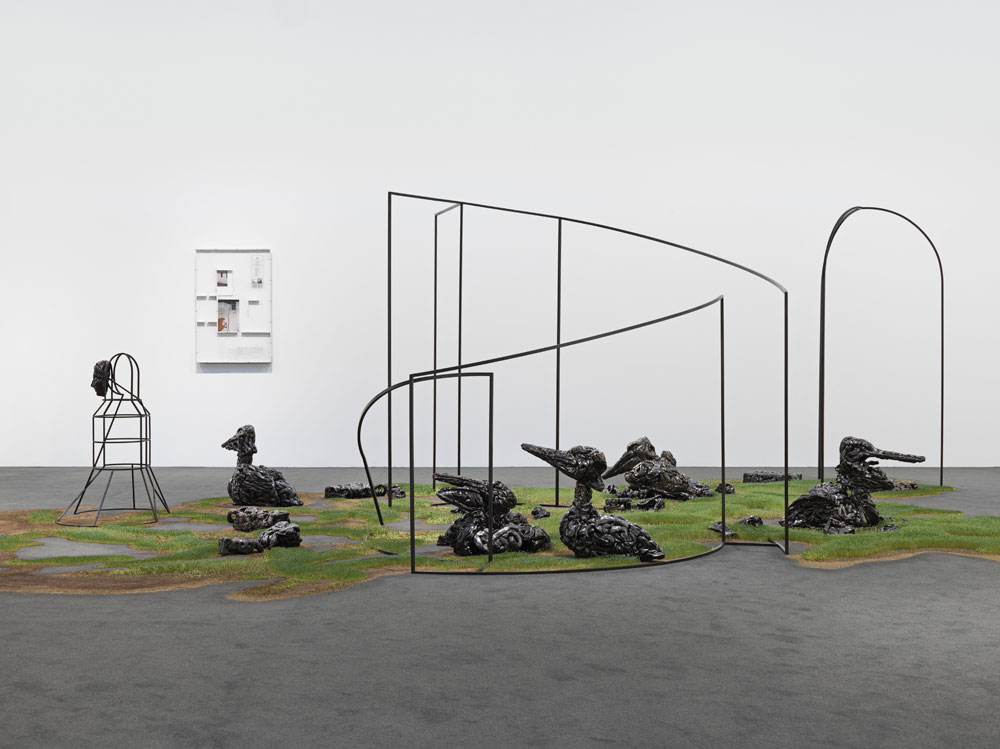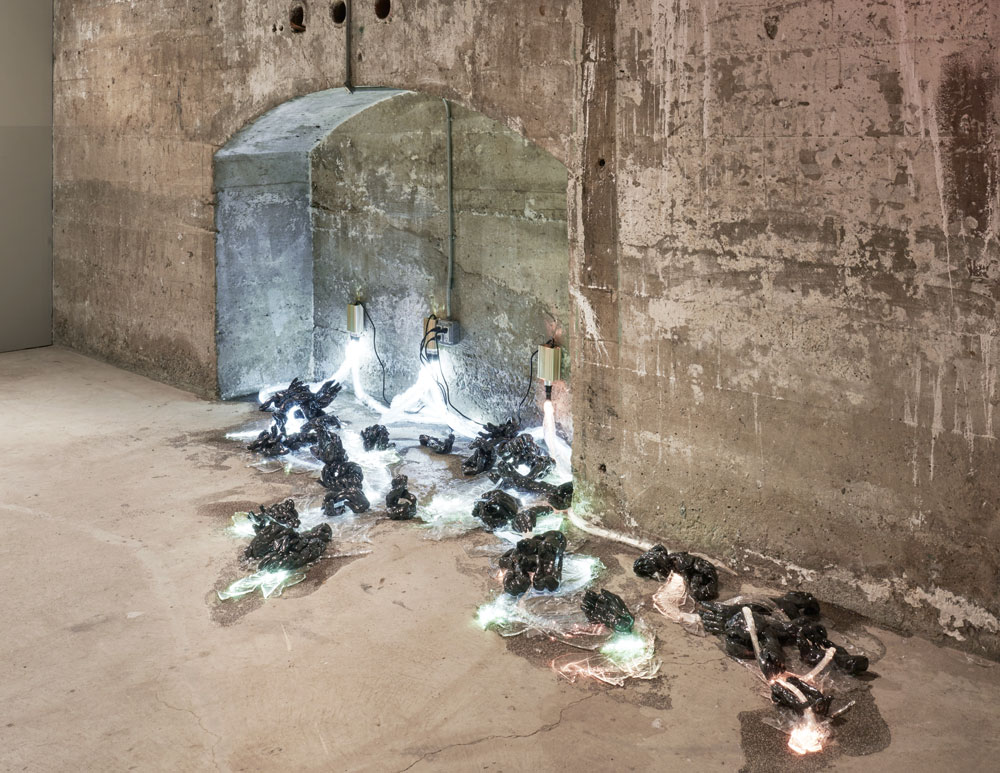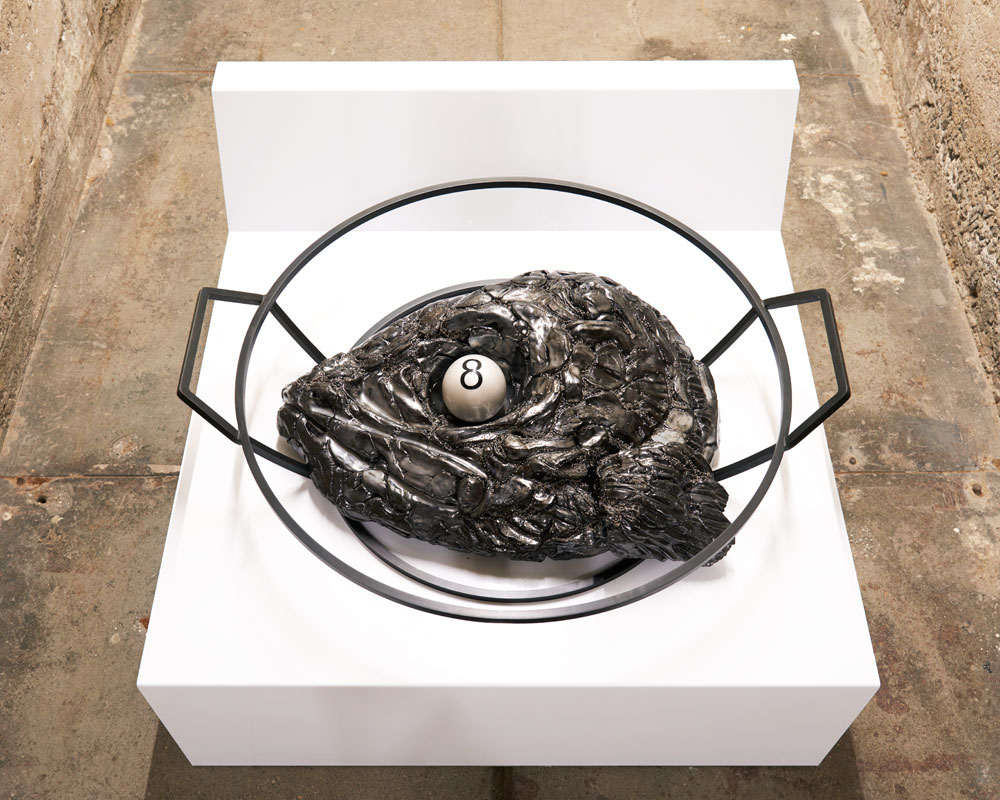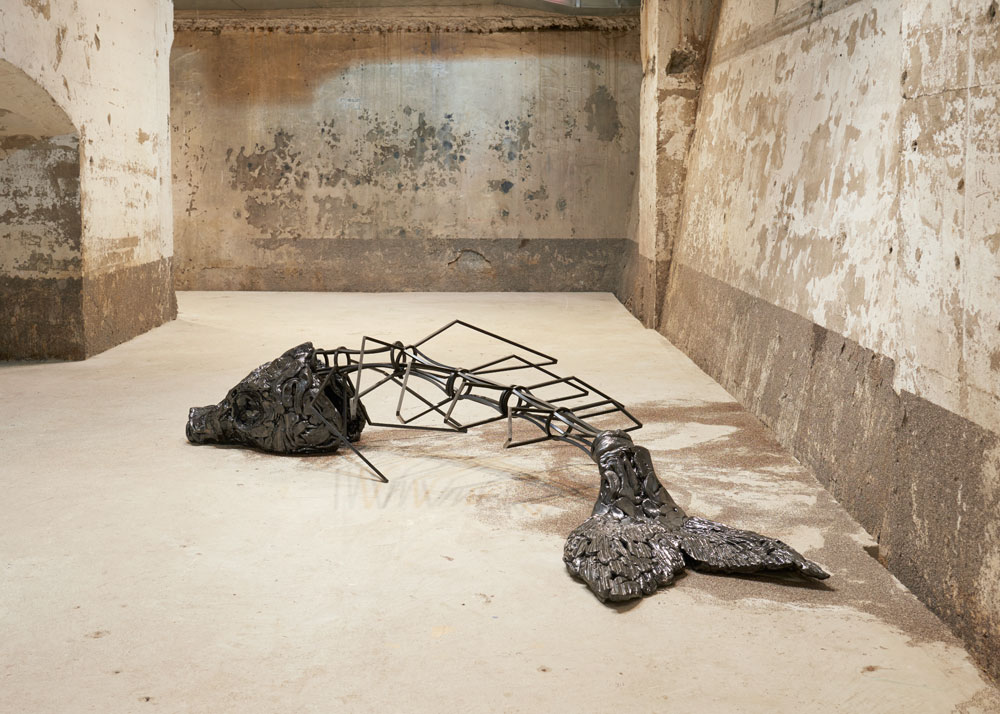“An interesting property of crude oil is, if you spill it, it doesn’t stop seeping,” says Rochelle Goldberg. “As a leaky substance, it continues to move. It doesn’t have a definable border—even if the economic infrastructure it flows through falsely reinforces one.”
This makes it the perfect material for Goldberg, a Brooklyn-based artist who has used buckets of crude oil alongside steel, clay, LED lights, fibre-optic cables, plastic, sprouted chia and even live snails, in sprawling installations that dissolve boundaries between figure and floor, living and static, inside and out. In her piece No Where, Now Here (2016), included in the group show “Mirror Cells” at the Whitney Museum of American Art in New York this past summer, life-sized ceramic pelicans and snakes roost and writhe on islands of chia growing in the carpeted gallery. A spare steel frame curves through the scene. Finished with a dark, opalescent glaze, the ceramic animals might be emerging from a tar-sands tailing pond.
But Goldberg, who grew up in Vancouver and received her MFA from Bard College in 2015, appears less concerned with pushing an environmental message than she is with creating topography. Her installations often look like aerial views of non-urban landscapes. Jane Panetta, an associate curator at the Whitney who co-curated “Mirror Cells,” compares Goldberg’s work both to Renaissance landscapes and to floor-based works by Lynda Benglis, who poured latex directly onto the ground. “Rochelle’s work feels very much like this two-dimensional thing made three-dimensional,” says Panetta. “It feels like a drawing in space.”
It can also feel like a small experiment in creating a living ecology, what Goldberg calls “worlding.” Hence her interest in chia, as well as the aforementioned live snails. Goldberg rescued them from a vacant lot behind the Milan gallery where she had a solo show last year. “They slid everywhere, extending the contours of the installation,” she says. “Their tracks necessarily widened the circuit.”
Besides finding interactions between new materials, Goldberg cites “peer energy” as one of her chief inspirations. “The advantage [of being in New York] is that there’s a community, a support system and a conversation happening here,” she says. “That could happen anywhere. But for some reason, that’s happening for me in New York.”
Goldberg’s hybrid worlds benefit from peer energy of their own: the materials refract each other’s associations. Smooth plastic swaddles muddy hunks of clay, or fibre-optic cables—usually hidden behind walls and under pavement—coil around the gallery, out in the open. Goldberg is interested in the “collapsing of exterior and interior,” a process she compares to digestion: “literally the act of bringing something from the outside in, and back outside again. It’s not just an isolated loop. The collapse occurs and reoccurs simultaneously.” After all, she points out, “It’s not just the mouth that consumes. All modes of sensorial activity are an act of consumption.”
This spotlight article, adapted from the Fall 2016 issue of Canadian Art, has been generously supported by the RBC Emerging Artists Project.
 Rochelle Goldberg, No Where, Now Here, 2016. Stainless steel, ceramic, wood, chia and carpet, Dimensions variable. Courtesy Miguel Abreau Gallery, New York. Photo: Genevieve Hanson.
Rochelle Goldberg, No Where, Now Here, 2016. Stainless steel, ceramic, wood, chia and carpet, Dimensions variable. Courtesy Miguel Abreau Gallery, New York. Photo: Genevieve Hanson.
 Rochelle Goldberg, Hands Replace the Deck, 2016. Ceramic, fiber optic cables, resin, chia, LED illuminator and plastic., Dimensions variable. Installation view at SculptureCenter, New York. Photo: Kyle Knodell.
Rochelle Goldberg, Hands Replace the Deck, 2016. Ceramic, fiber optic cables, resin, chia, LED illuminator and plastic., Dimensions variable. Installation view at SculptureCenter, New York. Photo: Kyle Knodell.
 Rochelle Goldberg, Dead Pan Fish Revival, 2016. Ceramic, chia, lacquered wood and steel, 104.1 x 101.6 x 53.3 cm. Installation view at SculptureCenter, New York. Photo: Kyle Knodell.
Rochelle Goldberg, Dead Pan Fish Revival, 2016. Ceramic, chia, lacquered wood and steel, 104.1 x 101.6 x 53.3 cm. Installation view at SculptureCenter, New York. Photo: Kyle Knodell.

 Rochelle Goldberg, For every living carcass I, 2016. Ceramic, steel, latex and chia, Dimensions variable. Installation view at SculptureCenter, New York. Photo: Kyle Knodell.
Rochelle Goldberg, For every living carcass I, 2016. Ceramic, steel, latex and chia, Dimensions variable. Installation view at SculptureCenter, New York. Photo: Kyle Knodell.







